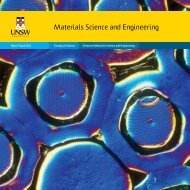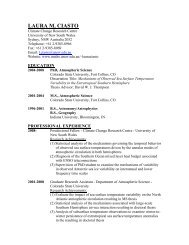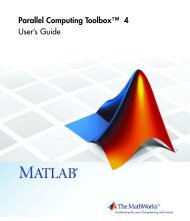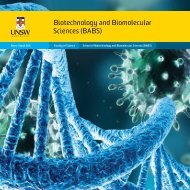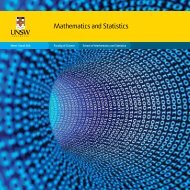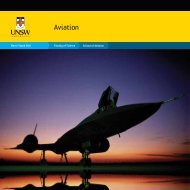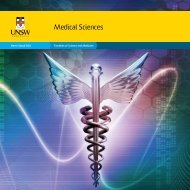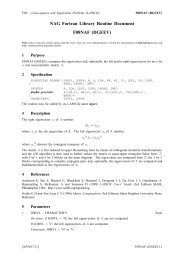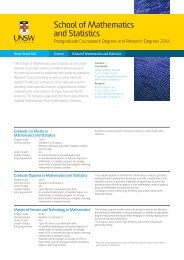2011 Postgraduate Research Competition - UNSW Science - The ...
2011 Postgraduate Research Competition - UNSW Science - The ...
2011 Postgraduate Research Competition - UNSW Science - The ...
You also want an ePaper? Increase the reach of your titles
YUMPU automatically turns print PDFs into web optimized ePapers that Google loves.
Page |25<br />
Structure analysis and modelling of the packing of<br />
ternary mixtures of spheres<br />
Liangyu Yi and Aibing Yu<br />
School of Materials <strong>Science</strong> & Engineering<br />
Abstract<br />
<strong>The</strong> packing of multi-sized particles is important to many industrial processes. While the<br />
packing structure often determines the process performance, it is not easy to be obtained<br />
experimentally and the fundamental understanding of it is far from well known. This work has<br />
presented a numerical study of the packing of ternary mixture of spheres with size ratios of<br />
24.4/11.6/6.4 (approximately 4:2:1) by means of the discrete element method (DEM). Good<br />
agreement between the simulated and measured coordination numbers was obtained,<br />
which validated the DEM model at a particle scale. By the reliable and well controllable<br />
numerical experiments, rich and detailed data were generated and analysed, and a model<br />
was established to predict the coordination number of the ternary system with any volume<br />
fraction ratios of the components. <strong>The</strong> structure was further analysed by the so-called radical<br />
tessellation, which divides the whole packing into unit cells, each containing a single particle.<br />
<strong>The</strong> detailed topological and metric properties of radical polyhedron were studied and<br />
modelled against particle size distribution. <strong>The</strong> present study provides a comprehensive and<br />
insightful understanding of the packing structure of the ternary mixtures of spheres, and could<br />
be further extended to the general multi-sized systems.<br />
Abstract<br />
Highly Photocatalytic Titanium Dioxide Spheres<br />
Xiaohong Yang and Aibing Yu<br />
School of Materials <strong>Science</strong> and Engineering<br />
Monodispersed titanium dioxide (TiO2) spheres with enhanced photocatalytic activity have<br />
been synthesized via a simple but efficient method at room temperature. By this method, the<br />
monodispersed titanium glycolate colloids can be first generated with diameters of 60-1000<br />
nm by optimizing experimental parameters (e.g., concentration, time, and temperature). <strong>The</strong><br />
proposed approach shows a few unique features, including: short reaction time (within a few<br />
minutes), high yield, and reproducibility. <strong>The</strong>se titanium glycolate colloids can be further<br />
processed to be TiO2 particles with large surface areas via hydrothermal treatment at 100 o C<br />
or calcinations at around 500 o C, confirmed by various advanced techniques (TEM, TGA,<br />
FTIR, XRD, BET and ESI). Interestingly, the enhanced photocatalytic activity of these TiO2<br />
nanoparticles was finally confirmed by measuring the decolourization of organic dye<br />
molecules (e.g., phenolphthalein) under UV irradiation.<br />
|energy + materials technologies



